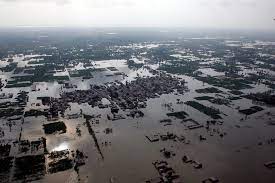Web Desk
Pakistan is facing the worst climate-induced damage in recent world history, with 33 million people affected by the floods.
“The magnitude of this loss is huge compared to our resources, however, our commitment is also big”, Planning and Development Minister Ahsan Iqbal told a news conference at The National Flood Response Coordination Centre (NFRCC) in the capital Islamabad on Saturday.
” It is impossible to face the calamity alone. World community should come forward to help rehabilitate the people affected by floods,” the minister said.
Highlighting the devastating loss across the country, he stated that 1,500 mm of rain fell in some areas, compared to the 20-30 mm average of previous years and that the regions of South Punjab, Dir, Nowshera and Charsadda were badly affected.
“More than one million houses were damaged, about 5,000 kilometres of roads were ruined and a fortnight ago, 14 major highways connecting the country’s main logistics hubs were cut off.”
Discussing relief efforts, Ahsan Iqbal said that the Pakistani armed forces and other agencies jointly repaired some of the highways while the remaining ones would also be restored in the coming days.
He further said recovery efforts in Punjab were rapidly undertaken, adding that Dera Ghazi Khan was badly affected by inundation which left 54 dead.
Commenting on the situation in Sindh, Ahsan maintained that the water drainage was slow with 230 perishing in the province.
So far, 69 of the 81 submerged grid stations have been restored, and 758 of the 881 feeders damaged were repaired while work was ongoing on the remaining 123, he said.
“2,900 of the 3,500 mobile phone towers affected have been restored,” said the planning minister, adding that the prime minister had issued directions to fix the remaining 600 towers soon.
Ahsan further said that the armed forces, government, and civil society would be integrated with the response centre and that every Pakistani who wants to donate should donate to armed forces centres established across the country to collect donations.
Chairman NDMA Lieutenant General Akhtar Nawaz underlined that the meteorological department had predicted 20-25% more rain in the country, whereas in actuality, Pakistan saw more than 190% of its usual rainfall.
“These rains used to occur in Kashmir, North and Central Punjab, however, this time there were heavy rains in Southern K-P, Punjab, DG Khan, Rajanpur and Sindh,” he added.
According to the NDMA chief, 1,265 people were killed by the floods so far, most of whom were children.
Moreover, 5,563 km of roads were damaged, 1.4 million houses were destroyed and 735,000 cattle were washed away in the floods, Gen Nawaz maintained.
“A high power committee was established for relief at the federal level and seeing the situation, a national emergency was declared”, he said.
As part of the relief efforts, Rs25,000 were given to every household and 57,400 food packages of 90 kilogrammes each were distributed to the victims, he said.
The disaster management agency chairman also announced that flights bearing relief food arrived from Turkey, China, and France, and 98 tons of dry fruits, boats, and medicine will be arriving from Turkey.
Earlier this week, the incumbent coalition government decided to establish the NFRCC to cope with the flood situation and rehabilitate the impacted people.
The decision was made at a meeting of the allied parties chaired by Prime Minister Shehbaz Sharif. The NDMA chief briefed the meeting about the situation of floods in the country and relief activities.
PM Shehbaz said that the centre would “serve as a bridge between disaster management authorities, donors and government institutions”.
According to the premier, the NFRCC would collect and analyse the latest information and pass it on to relevant government agencies, as well as oversee rescue and relief work, including the restoration of infrastructure.













